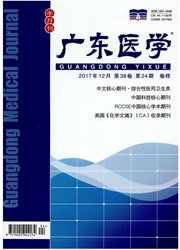

 中文摘要:
中文摘要:
目的 探讨影响急性心肌梗死(AMI)患者院内并发心室颤动(VF)的危险因素。方法 885例AMI患者根据住院期间是否发生VF分成两组:VF组(n=28)和非VF组(n=857),回顾性分析两组患者的临床资料,并对相关危险因素进行单因素及多因素分析,探讨AMI患者院内发生VF的独立危险因素。结果 885例AMI患者中,28例发生VF(3.1%)。单因素分析表明,VF组患者的入院时收缩压和左室射血分数(EF)明显低于非VF组(P〈0.05);而慢性肾功能不全病史、前壁心肌梗死、心房颤动、Killip分级〉Ⅱ级和心源性休克患者的比例,以及心率、呼吸频率、空腹血糖、血清肌酐(Cr)、血清肌酸激酶MB同工酶(CK-MB)和血清肌钙蛋白Ⅰ(c TNI)等指标均明显高于非室颤组,差异有显著性意义(P〈0.05)。多因素Logistic回归分析表明,慢性肾功能不全(OR=2.313)、心源性休克(OR=4.193)、心房纤颤(OR=2.823)、Killip分级〉Ⅱ级(OR=3.674)是AMI患者住院期间并发VF的独立危险因素。结论 慢性肾功能不全、心源性休克、心房纤颤、Killip分级〉Ⅱ级是急性心肌梗死患者住院期间并发室颤的独立危险因素。
 英文摘要:
英文摘要:
Objective To investigate the risk factors for ventricular fibrillation(VF) in patients with acute myo- cardial infarction (AMI) during hospitalization. Methods 885 AMI patients were divided into the VF group (n = 28) and the non - VF group ( n = 857). Clinical data of the two groups were retrospectively analyzed. Single and multiple factor analyses were used to investigate the independent risk factors for the development of VF in AMI patients during hospi- talization. Results Among the 885 AMI cases, 28 cases had ventricular fibrillation and the incidence was 3.1%. Single factor analysis showed that systolic blood pressure and left ventricular ejection fraction (EF) in the VF group were lower than those in the non - VF group ( P 〈0. 05 ), while heart rate and breathing rate on admission, fasting glucose, Cr, CK - MB, cTNI and the rate of chronic renal insufficiency, anterior wall myocardial infarction, atrial fibrillation, Killip classification 〉 Ⅱ and cardiac shock in the VF group were all higher than those in the non - VF group ( P 〈0. 05). Multi- variate logistic regression analysis showed that chronic renal insufficiency ( OR = 2. 313 ), cardiac shock ( OR -4. 193 ), atrial fibrillation (OR =2. 823 ) and Killip classification 〉 Ⅱ (OR = 3. 674) were independent risk factors for the devel- opment of VF in AMI patients during hospitalization. Conclusion Chronic renal insufficiency, cardiac shock, atrial fi- brillation, Killip classification 〉 Ⅱ were independent risk factors of ventricular fibrillation in patients with acute myocardial infarction during hospitalization.
 同期刊论文项目
同期刊论文项目
 同项目期刊论文
同项目期刊论文
 期刊信息
期刊信息
